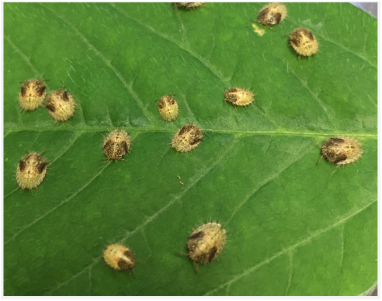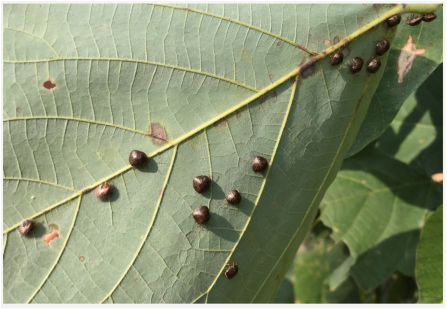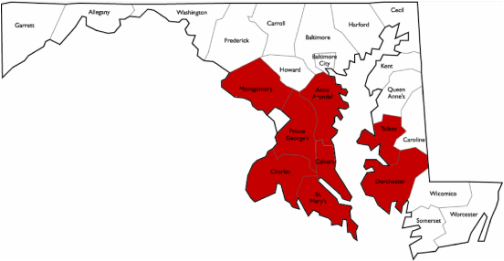|
The kudzu bug (Megacopta cribraria) (Family Plataspidae) (Fig. 1) has become a widespread invasive pest in the southern United States since it was first detected in Georgia in 2009. This small, round bug is closely related to stinkbugs (Pentatomidae) and has plagued soybean farmers under non-treatment and high density conditions with yield losses as high as 59%! It feeds on the soybean plants’ leaves and stems with its piercing-sucking mouthparts, which can affect the number of seeds per pod and overall seed weight. The overall damage is astounding, especially when considering all kudzu bugs in North America originated from a single female bug from Japan. Luckily, many studies have been done to track and monitor this pest, such as those done by Jessica Grant. Jessica, a Masters student in the Lamp Lab at the University of Maryland, has been studying the cold tolerance and phenology of the kudzu bug. Using past weather data as well as future projections, she has been able to make some powerful predictions about the range, potential severity, and management options for this agricultural pest. Figure 1. Nymphs (left) and adults (right) of the kudzu bug. Photo credits: Jessica Grant Kudzu bugs have steadily increased their range in the U.S. since 2009 and were detected in southern Maryland by 2013. However, Jessica observed that the northward expansion of their range stalled once they reached our state, only going as far north as Montgomery County (Fig. 2). Insects are often limited in their range by how well they survive the cold of winter. Were the winters in Montgomery County the upper limit for these bugs? If not, how much further north could the kudzu bug establish new populations? To answer these questions, Jessica first began by freezing a lot of adult kudzu bugs, because adults that survive the winter proliferate in the spring. She determined the average temperatures at which individual kudzu bugs froze solid, a chilly -12.6°C (9.3°F), and the temperature at which half the population of a group of bugs would die, or -5.1°C (22.8°F). The temperature at which they froze, which is lethal to the bugs, lined up with the current northern distribution limit and a map of lowest minimum winter temperatures. Jessica showed that at present climate conditions the kudzu bug was unlikely to move further north than Maryland. Although southern Maryland may not be known for frigid winters, low temperatures below 22.8°F are hardly unheard of. If that temperature would normally put a significant dent in the bug population, how were they surviving in the large numbers observed in the field? Jessica found the answer lay more in behavior rather than physiology.
She observed that between November and December, adult kudzu bugs preparing to overwinter would migrate from the kudzu vines (Fig. 3) to the dead leaves littering the ground. Temperature monitors showed that these patches of leaf litter were roughly 2°C warmer than air temperatures through the winter. While that may seem like a miniscule advantage for the kudzu bug, Jessica showed that just adding that extra bit of warmth greatly reduced the number of hours the bugs would be subjected to temperatures below 22.8°F, and may help explain how the bugs are able to survive. In Maryland, however, surviving does not necessarily mean thriving, at least not at our current winter temperatures. As winter lows are projected to warm in the future, we may begin to see range expansion and larger populations of the bug in our state. This research into the cold tolerance of kudzu bugs facilitates the development of management recommendations for farmers who stand to lose the most from this agricultural pest. As of right now, Jessica believes the kudzu bug’s impact in Maryland will be limited, as the bug has not yet been observed leaving the kudzu patches for the soybean fields here. Soybean farmers should remain aware but maybe not worry too much just yet. Jessica’s research provides insight into possible range expansion, as well as timing and severity of outbreaks of the bug depending on future weather While the kudzu bug does not currently cause losses in Maryland’s soybean yields, these predictive analyses allow a window into the future of what management practices might be necessary. Based on her work, Jessica would recommend once insecticide treatment, should the kudzu bug make its way into soybean fields. Such treatments would be ideally timed with high nymph and low adult presence, as nymphs are less mobile and thus more susceptible to insecticides. So fear not farmers! Even if the cold of winter fails to stop the kudzu bug, you can rest easy knowing you have viable management options up your sleeve should the need arise! About the Authors: Becca Wilson is a PhD candidate in the Lamp Lab. She studies the spatial distribution and societal impacts of nuisance black flies in western Maryland. Kelly Kulhanek is a PhD student in the vanEngelsdorp Lab. She is working to develop, validate, and implement best honey bee management practices for beekeepers across the US. Anthony Nearman is a PhD student in the vanEngelsdorp Lab. He studies honey bee immunological responses to invading pathogens. Comments are closed.
|
Categories
All
Archives
March 2024
|
Department of Entomology
University of Maryland
4112 Plant Sciences Building
College Park, MD 20742-4454
USA
Telephone: 301.405.3911
Fax: 301.314.9290
University of Maryland
4112 Plant Sciences Building
College Park, MD 20742-4454
USA
Telephone: 301.405.3911
Fax: 301.314.9290





 RSS Feed
RSS Feed




